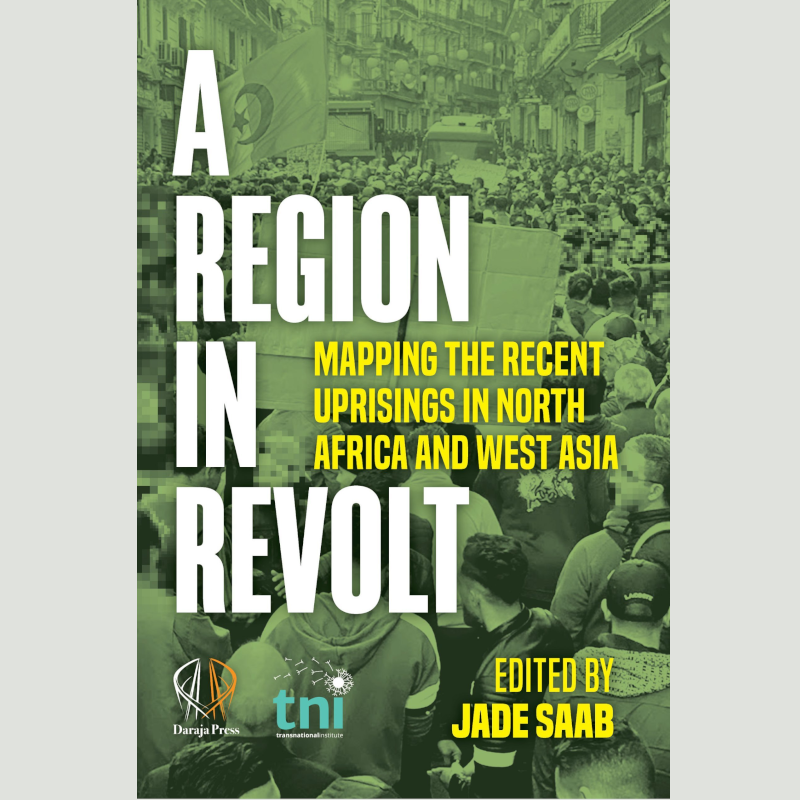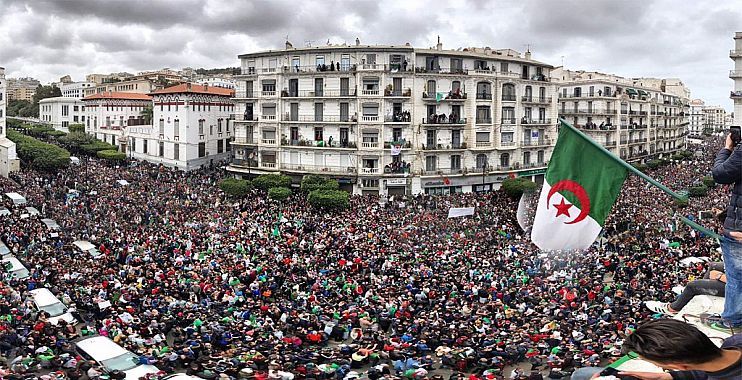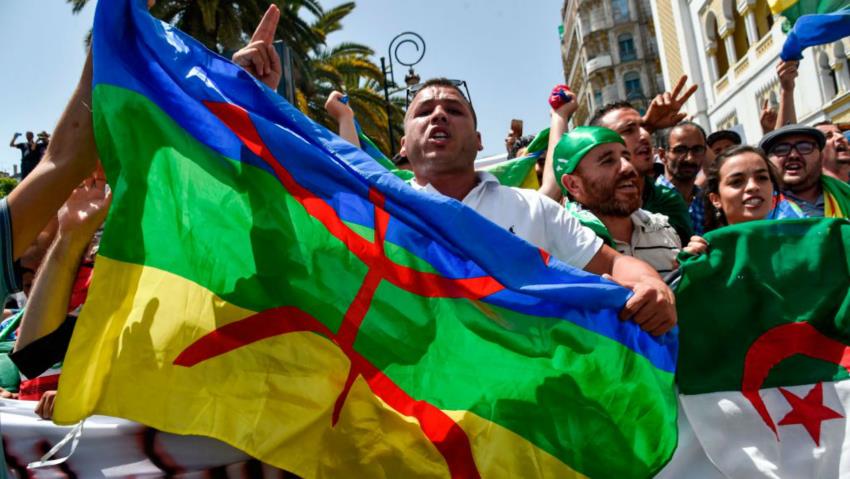A revolution in permanence
Algeria’s Hirak and the anti-colonial fight

A Region in Revolt
Mapping the recent uprisings in North Africa and West Asia
by Jade Saab (Editor)
Daraja Press, 2020

Sam Salour summarizes A Region in Revolt: Mapping the Recent Uprisings in North Africa and West Asia edited by Jade Saab, a collection of essays that provides a comprehensive review of the 2018-2019 wave of struggle in the region. In the second part of this multi-part series, Salour provides an introduction to the book and then outlines the essay “The Algerian revolution: the struggle for decolonisation continues” by Hamza Hamouchene and Selma Omari.
Starting in 2018, a wave of revolutionary uprisings swept over the region commonly referred to as the Middle East and North Africa. Protesters in Sudan, Algeria, Iraq, Lebanon, and Iran took to the streets to demand the overthrow of their respective authoritarian regimes. While recognizing the common characteristics of these protests, the essays collected in the book A Region in Revolt: Mapping the Recent Uprisings in North Africa and West Asia emphasize the specific historical, political, and economic contexts of each country, highlighting the key actors involved, their goals, their weaknesses, and their possibilities.

The economies of the region—in the absence of a developed manufacturing sector—rely on oil and gas exports. The wealth extracted from natural resources is distributed amongst corrupt elites and military apparatuses, while the domestic markets are opened up to the cheap goods of industrialized nations. Speculative adventures in real estate and banking siphon off capital, paralyzing domestic productive investment. The consequence for the vast majority of the population has been unemployment, marginalization, and poverty. These economic realities, along with the climate of corruption, political repression, oppression of women, and discrimination against minorities, created pre-revolutionary conditions in the region as a whole. Although all of these movements are revolutionary in their aspirations—demanding systemic change—it remains to be seen whether any of them can achieve revolutionary outcomes.
The movements in Algeria, Iraq, Lebanon, and Iran have been characterized by oppositional protests and the rejection of ruling elites, but have not been able to unite behind a set of positive demands. While the lack of leadership has prevented the co-optation of the movements by existing political parties, it has also hampered their further development. Algeria’s popular movement—sparked by President Abdelaziz Bouteflika’s pursuit of a fifth presidential term—demanded fundamental political change, rejecting le pouvoir, the ruling clique of army generals and businessmen. Millions of people took to the streets. But the movement ultimately struggled to generate the level of organization that could successfully challenge the ruling class’s attempt to dispose of Bouteflika and maintain the old regime with new faces.
The authors of the collection emphasize the importance of regional and international solidarity against the powers of international finance. While the struggle against imperialism and global capital does not imply defending reactionary regimes such as the Islamic Republic of Iran as the lesser evil, it does require a revolutionary vision that goes beyond overthrowing national authoritarian regimes. Although the different uprisings have shown awareness of the global setting of their struggle and the need for regional solidarity, concrete instances of collaboration are yet to come. It is the role of the global Left to help create the space for practical solidarity between movements.
Most of the essays in this collection are written by members of the Alliance of Middle Eastern and North African Socialists. The Alliance originally started in March 2016 as a grouping of Syrian and Iranian Socialists with a trilingual website (English/Arabic/Persian) to help express the aspirations of “the Other Middle East” to offer analyses of critical issues, host new conversations, and build bonds of solidarity between Syrians and Iranians opposed to their respective authoritarian regimes. Since then, the Alliance has grown to include members in all the countries covered in this collection (and others) while continuing its mission to provide and amplify socialist perspectives from the region.
Algeria’s Hirak
Activist-scholars Hamza Hamouchene and Selma Omari outline how the 2019 revolution in Algeria, similarly to that of Sudan, came as the culmination of decades of struggle and resistance against a violent military regime, repression of women and national minorities, anti-Black racism, privation of basic freedoms, and severe austerity measures resulting from forced liberalization demanded by the International Monetary Fund and the World Bank.
The latest revolution can be seen as part of a lineage of revolt. The first serious challenge to the Bouteflika regime came from the democratic mass movement of the Berbers/Amazighs of Kabylia in the 1980s, who sought to affirm their linguistic and cultural identity against Arabization measures. In the early 2000s, following the previous decade’s Civil War, there was a blossoming of activism expressed in the revival of the feminist movement, the formation of independent trade unions, and a youth revolt against police brutality. Despite severe repression, these movements made tremendous gains, such as the official recognition of Tamazight as a national language in 2011, and the building of solidarity amongst activists from different regions and ethnicities. An inspiring episode was the anti-shale gas movement in 2015, where activists in different regions in the south coordinated to oppose fracking, bringing to the forefront concerns over extractivism and the sacrifice of nature and communities in the name of attracting international capital.

The immediate context of the 2019 uprising was an acute economic crisis and suffocating austerity measures by the state, in response to the decline of oil and gas export revenues. The economic crisis needs to be understood against the broader political backdrop of a corrupt military-oligarchic nexus that denies the Algerian people their right to self-determination and dispenses with popular legitimacy for the benefit of domestic and international capital.
The Hirak (popular movement) began on February 22, 2019 against the dictatorial regime of President Abdelaziz Bouteflika, and successfully overthrew him in early April 2019. The military, under Army Chief of Staff Gaid Saleh, backed by the reactionary governments of Saudi Arabia and the United Arab Emirates, took de facto control of the country. Since independence in 1962, the military had always held a certain legitimacy in the eyes of Algerians as the direct descendant of the national liberation army that fought against French colonialism. However, as the military high command rejected all proposals by the protesters and refused to open up dialogue, people became disillusioned with Saleh and his military regime and demanded a civilian government. The opposition to the status quo continued unabated until the first months of 2020 when the global health crisis forced the Hirak to halt its weekly marches and protests.
As in the revolution in Sudan, women played a significant role in the Algerian uprising. They were at the forefront of the student movement that kept up regular weekly everyTuesday for an entire year. Considering that women are treated as second class citizens, feminist organizations, inspired by achievements in Tunisia, have been doing their best to put women’s liberation at the center of this democratic revolution.
Marginalized workers and the unemployed youth formed the mass of the protesters, expressing their anger at socioeconomic exclusion and forced pauperization. Unlike in Sudan, however, there was no revolutionary leadership nor counter-power institutions similar to the Sudanese grassroots neighborhood-based Resistance and Change Committees.
However, political parties and independent trade unions have failed to root themselves in poor and working class communities and to give political expression to the movement. Although the re-appropriation of public spaces has created the opportunity for people to discuss, debate, and strategize, it has failed to give rise to institutions that can form the basis of a potential dual power situation. Hamouchene and Omari argue that the “leaderless and loose character of the uprising” has been its Achilles heel and that to “overcome the organized counter-revolution, there is a need for coherent revolutionary organizations with strong leadership and strategic visions.”
The unique feature of the Algerian uprising, which underlies its anti-imperialist and anti-capitalist potential, is its anti-colonial character. Algerians see their protests as a continuation of the struggles of the 1950s against French colonialism that were left uncompleted as corrupt neo-colonial elites who facilitate the looting of the country by international capital remain in power and a popular, democratic civilian government was not achieved. The anti-colonial nature of the struggle shows itself most clearly in their unshakable solidarity with the Palestinian struggle. Having themselves experienced racist, genocidal settler-colonialism, Algerians fully understand that their liberation is bound up with that of the Palestinians.
Although the protests have mostly ceased due to the COVID-19 pandemic, the movement has not died out but metamorphosed into grassroots health campaigns and mutual aid networks. Although the dampening effects of COVID-19 on the movement have been a blessing for the ruling classes, there is no doubt that the Hirak will revive as the pandemic subsides; because the conditions that gave rise to it in the first place have not only not gone away but have been exacerbated. The authors contend that for the Hirak to consolidate itself, it needs to build grassroot institutions such as neighborhood committees, insist on individual and collective freedoms at every level, and wed “social justice and socioeconomic rights to democratic demands.” Revolution cannot be halted half-way. The struggle for democratization will go on.
Categories
We want to hear what you think. Contact us at editors@tempestmag.org.
Sam Salour View All
Sam Salour is a writer and activist in New York City. He is a member of DSA and the Tempest Collective.
